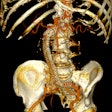The use of cross-sectional imaging and 3D printing may enhance the teaching of spinal anatomy in undergraduate medical education, according to a field study published on 2 November in Academic Radiology.
A team at the University of Granada in Spain compared the use of conventional approaches with cross-sectional imaging and 3D printing among groups of students and found those using the new tools demonstrated better knowledge outcomes.
“Cross-sectional imaging and 3D printing offer valuable tools for enhancing the teaching of spinal anatomy in undergraduate medical education,” wrote first author Dr. Antonio Jesús Láinez Ramos-Bossini and colleagues.
Current spatial understanding among students of many anatomical structures is based on conventional anatomical illustrations. This approach is hampered by intrinsic limitations of two-dimensional representations, however, and this may translate into problems in recognizing anatomy in the clinical setting, according to the authors.
Conversely, cross-sectional imaging and 3D printing represent state-of-the-art approaches to improve anatomy teaching compared with traditional learning, but their use in medical schools remains limited, they added.
Thus, the group explored implementing these tools and aimed to determine whether they could be used to improve undergraduate medical education.
The researchers selected 40 undergraduate students in the same basic anatomy course and divided them into two groups. Twenty students were exposed to standard learning, cross-sectional imaging, and 3D-printed models during the academic year to learn basic concepts, and 20 students only received the standard university training. The study was conducted during the university’s second semester between February and July 2022.
The control group received a total of 10 hours of conventional theory regarding the normal and pathological spine, and 10 hours of practice with traditional 2D illustrations and ideal anatomical models of the spine, in alignment with the standard university curriculum.
The intervention group was exposed to an identical 10-hour conventional theory program, yet further engaged in a 10-hour practice regimen using interactive 3D models, cross-sectional imaging examinations (CT and MRI), and 3D printed models.
After the learning period, both groups took a 20-question multiple-choice test on spinal anatomy and spinal conditions with four possible answers and only one correct answer.
According to the findings, students exposed to cross-sectional imaging and 3D printing demonstrated better knowledge outcomes compared to the control group. In general, the experimental group showed a higher frequency of correct answers than the control group (79.8% vs. 55.3%).
However, the rate of students who passed the test did not significantly differ between both, the group added.
Ultimately, the results are in agreement with those found in previous studies, although the corpus of evidence in this area is still limited, the researchers wrote. Nonetheless, both anatomists and clinicians agree that accurate knowledge of anatomy and variations is vital to ensure safe and efficient clinical practice, they added.
“Radiologists are well positioned to lead the integration of these technologies, and further research should explore their potential in teaching anatomy across different anatomical regions,” the group concluded.
The full article is available here.



















